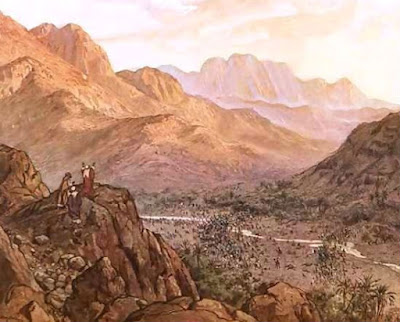When I first learned about the names of God and that the meaning of Jehovah Nissi was the Lord my banner, I didn’t get it. In my mind, I pictured something like a welcome home or a happy birthday banner. I knew that couldn’t be it, so I considered the sashes worn over the shoulder and draped across the body of beauty contestants to identify what state they represent. It sounded like a plausible guess, but that isn't the way to approach Scripture. When it comes to understanding Scripture, we are to be diligent to present ourselves approved to God as a workman who does not need to be ashamed, accurately handling the word of truth (2 Tim. 2:15).
Digging into the Jehovah Nissi meaning
In the Old Testament, the name Jehovah Nissi occurs one time in Exodus 17:15. “Moses built an altar and named it The Lord is My Banner” (NASB). In the King James, it reads “And Moses built an altar, and called the name of it Jehovahnissi.” The New King James reads, “And Moses built an altar and called its name, The-Lord-Is-My-Banner” with a footnote stating that in the Hebrew it is YHWH Nissi.
The writers of the Septuagint (Greek version of the Old Testament) translated Jehovah-Nissi as “the Lord My Refuge.” The Latin Vulgate translators who translated from the Hebrew, rendered it “Jehovah Is My Exaltation.” While I love the concept of both of these meanings, for me, it did not clear up my question of what Jehovah Nissi means. Since our modern translations say it means the Lord my banner in Hebrew, I figured it might be best to see what that word banner meant to them. That might help me understand what the name means in context.
Jehovah Nissi meaning in context
For just a moment forget the word banner and look at the context of the verse in which the name is used. It’s “the name given by Moses to the altar….” That’s the first thing I want to point out. And then what was the reason for building the altar? It was built following the battle with Amalek against Israel at Rephidim. Moses instructed Joshua to choose men to fight the battle the following day and said, “Tomorrow I will station myself on the top of the hill with the staff of God in my hand.”
That day while Joshua and his men fought the battle, Moses, Aaron, and a man named Hur went up to the top of the hill. While Moses held his hands up, Israel prevailed, but when he let his hands drop Amalek prevailed. As the battle went on, Moses’ hands grew heavy. Aaron and Hur had him sit on a stone and then supported his hands from each side. In this way, his hands stayed steady until sunset, and Amalek and his people were overcome.
The
altar was built to commemorate that defeat. Now that we understand that, we can
go back to looking at the word “banner.” According to Strong’s Concordance, the
word used in this verse refers to “banner, pole, sail, ensign, standard.”
During the time of Moses, the banners the armies of other nations carried into
battle served as their rallying flag. That verb rally means “to reunite; to
collect and reduce to order troops dispersed or thrown into confusion.” For
Moses to name the altar Jehovah Nissi, he was declaring to the world that God
was the source of victory and a rallying point for His people. As we call upon the name of Jehovah Nissi in prayer this is the context. Pray that we would unite and rally around Him as the source of victory.



